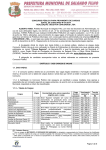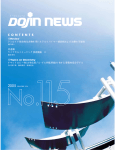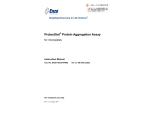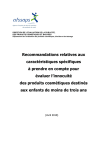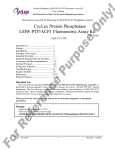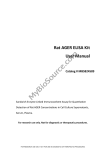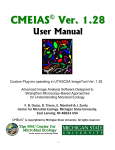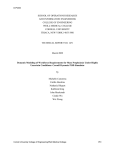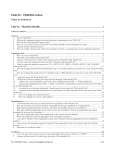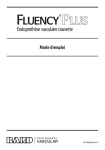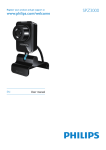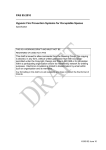Download User Manual - ENZ-51038-K040 - ProteoStat Amyloid Plaque
Transcript
Enabling Discovery in Life Science® ProteoStat® Amyloid Plaque Detection Kit for fluorescence microscopy Instruction Manual Cat. No. ENZ-51038-K040 For research use only. Rev. 1.0 October 2010 Notice to Purchaser The ProteoStat® Amyloid Plaque Detection Kit is a member of the CELLestial® product line, reagents and assay kits comprising fluorescent molecular probes that have been extensively benchmarked for cell analysis applications. CELLestial® reagents and kits are optimal for use in demanding cell analysis applications involving confocal microscopy, flow cytometry, microplate readers and HCS/HTS, where consistency and reproducibility are required. This product is manufactured and sold by ENZO LIFE SCIENCES, INC. for research use only by the end-user in the research market and is not intended for diagnostic or therapeutic use. Purchase does not include any right or license to use, develop or otherwise exploit this product commercially. Any commercial use, development or exploitation of this product or development using this product without the express prior written authorization of ENZO LIFE SCIENCES, INC. is strictly prohibited. Limited Warranty These products are offered under a limited warranty. The products are guaranteed to meet appropriate specifications described in the package insert at the time of shipment. Enzo Life Sciences’ sole obligation is to replace the product to the extent of the purchase price. All claims must be made to Enzo Life Sciences, Inc. within five (5) days of receipt of order. Trademarks and Patents Enzo, CELLestial and ProteoStat are trademarks of Enzo Life Sciences, Inc. Several of Enzo’s products and product applications are covered by US and foreign patents and patents pending. Contents I. Introduction ............................................................... 1 II. Reagents Provided and Storage.............................. 1 III. Additional Materials Required ................................. 2 IV. Safety Warnings and Precautions........................... 2 V. Methods and Procedures ......................................... 3 A. REAGENT PREPARATION ................................................... 3 B. STANING TISSUE SECTIONS .............................................. 3 VI. Appendices ............................................................... 8 A. FLUORESCENCE CHANNEL SELECTION FOR DATA COLLECTION .................................................... 6 B. EXPECTED RESULTS......................................................... 8 VII. References ................................................................ 9 VIII. Troubleshooting Guide ......................................... 10 I. Introduction Amyloid protein fibrils are characteristic of a variety of neurodegenerative diseases, including Alzheimer’s, Huntington’s and Parkinson’s diseases, as well as various transmissible spongiform encephalopathies.1,2 It is difficult to predict the presence of amyloid deposits solely on the basis of a patient’s clinical symptoms, and thus histopathological analysis is often required post-mortem to confirm a diagnosis. This is often accomplished by measuring the optical properties of specific probes upon their interaction with the amyloid fibrils. Thioflavin T has routinely been employed in this context.3 However, this dye is not an ideal predictor of the degree of fibrillization because its fluorescence varies substantially depending upon the structure and morphology of the amyloid fibrils. Also, the dye generates fairly high background and weak fluorescent signal in brain tissue sections. Enzo Life Sciences’ ProteoStat® Amyloid Plaque Detection Kit contains a novel 488 nm excitable red fluorescent molecular rotor dye to specifically detect amyloid plaques in cells and tissues. The detection reagent interacts with the cross-β-sheet quaternary structure of amyloid fibrils and is readily excited by an argon ion laser source, with emission maximum of 600 nm. Relative to Thioflavin T, this novel detection reagent demonstrates significantly higher fluorescence emission intensity enhancement in the presence of amyloid protein fibrils and low non-specific background. It is also suitable for highlighting neurofibrillary plaques, composed of ß-amyloid and tau proteins, in brain tissue thin sections from animal models or from post-mortem tissue sections of patients with Alzheimer's disease. The ProteoStat® Amyloid Plaque Detection Kit should facilitate the discovery of pharmaceuticals or therapies which prevent or slow Alzheimer’s disease progression. II. Reagents Provided and Storage All reagents are shipped on dry ice. Upon receipt, the kit should be stored at ≤-20°C, protected from light. When stored properly, these reagents are stable for one year from date of receipt. Avoid repeated freezing and thawing. Reagents provided in the kit are sufficient for approximately 40 tissue sections for analysis by fluorescence microscopy. Reagent Quantity ® ProteoStat Amyloid Detection Reagent 10 µL Antifade Reagent 2 mL 10X Assay Buffer 10 mL 1 III. Additional Materials Required Tissue Sections: For example, post-mortem brain tissue from patients with Alzheimer’s disease from BioChain Institute, Inc., Hayward, CA (T1236039Alz for frozen tissue and T2236039Alz for paraffin-embedded tissue), and human adult normal brain tissue (T1234041 for frozen tissue & T2244040 for paraffin-embedded tissue). Standard fluorescence microscope Calibrated, adjustable precision pipetters, preferably with disposable plastic tips Glass cover slips Coplin jars or equivalent Xylenes or xylene substitute (Thermo Scientific # 9990507) for paraffinembedded tissue sections 50%, 70%, 90% and 100% Alcohol (Reagent Grade) 1% acetic acid in water Paraformaldehyde Deionized or distilled water IV. Safety Warnings and Precautions This product is for research use only and is not intended for diagnostic purposes. The ProteoStat® Amyloid Detection Reagent contains DMSO which is readily absorbed through the skin. DMSO is harmful if ingested or absorbed through the skin and may cause irritation to the eyes. Observe appropriate precautions when handling these reagents. Reagents should be treated as possible mutagens and should be handled with care and disposed of properly. Observe good laboratory practices. Gloves, lab coat, and protective eyewear should always be worn. Never pipet by mouth. Do not eat, drink or smoke in the laboratory areas. All blood components and biological materials should be treated as potentially hazardous and handled as such. They should be disposed of in accordance with established safety procedures. To avoid photobleaching, perform all manipulations in low light environments or protected from light by other means. 2 V. Methods and Procedures NOTE: Allow all reagents to thaw at room temperature before starting with the procedures. Upon thawing, gently hand-mix or vortex the reagents prior to use to ensure a homogenous solution. Briefly centrifuge the vials at the time of first use, as well as for all subsequent uses, to gather the contents at the bottom of the tube. A. REAGENT PREPARATION 1. 1X Assay Buffer Allow the 10X Assay Buffer to warm to room temperature. Make sure that the reagent is free of any crystallization before dilution. Prepare enough 1X Assay Buffer for the number of samples to be assayed by diluting each milliliter (mL) of the 10X Assay Buffer with 9 mL of deionized water. 2. 4% Formaldehyde Solution The following procedure is for preparation of 10 mL of 4% formaldehyde solution: Dilute 0.4 gram paraformaldehyde to a final volume of 10 mL with 1X Assay Buffer. Mix well. 3. ProteoStat® Amyloid Detection Reagent For optimal staining, the concentration of the ProteoStat® Amyloid dye will vary depending upon the application and must be determined by the end user. The dilution suggested and described in the following paragraph serves only as a guideline. Modifications may be required depending upon the particular specimen type employed in the application. Dilute a sufficient amount of the ProteoStat® Amyloid Detection Reagent for the number of samples to be assayed as follows: For every 2 mL of 1X Assay Buffer (from section A1, above), add 1 µL of ProteoStat® Amyloid Detection Reagent. Mix well. B. STAINING TISSUE SECTIONS 1. Specimen Preparation and Pretreatment Tissue sections should be about 5 µm thick. Frozen tissue sections should be mounted on positively charged glass slides, and fixed with cold acetone. The embedded tissue sections should be fixed in formalin immediately after excision, and embedded in paraffin. Tissue sections should be mounted on positively charged glass slides. a. Paraffin-embedded Tissue Sections. Paraffin-embedded tissue sections should be deparaffinized prior to staining. Bake the microscope slide-mounted specimens at 60-80°C for 5-15 minutes 3 to melt the paraffin. Then the slides are immersed in a series of Coplin jars containing the following solutions, for the times indicated or until the paraffin is completely solubilized. Soak Number Reagent Duration of Soak 1 Xylenes 10 minutes 2 Xylenes 2 minutes NOTE: Use fresh reagents in each jar for each batch of slides and discard in appropriate waste containers when finished. Xylenes saturate rapidly with paraffin. Use fresh xylenes for each batch of 5 slides. b. Frozen Tissues Sections. Frozen tissue should be thawed at room temperature. 2. Wash the specimens, deparaffinized and frozen, sequentially in a series of Coplin jars containing the following solutions, for the times indicated: Soak Number Reagent Duration of Soak 3 100% alcohol 1 minute 4 100% alcohol 1 minute 5 90% alcohol 1 minute 6 70% alcohol 1 minute 7 50% alcohol 1 minute 8 Deionized Water 1 minute 3. Carefully remove excess water, dispense 200 µL of 4% formaldehyde (from section V-A2, page 3) per 1 cm2 surface of tissue for 15 min at 37°C. 4. After fixing, wash the tissue sections in deionized water. 5. Carefully remove excess water and and dispense 200 µL of ProteoStat® Detection Reagent (see section V-A3, page 3) per 1 cm2 surface to cover the tissue sections. 6. Protect samples from light and incubate for 3 minutes at room temperature. 7. Rinse the tissue sections in water and de-stain in 1% acetic acid for 20 min. 4 8. Finally, wash the de-stained tissue sections thoroughly in water. Dehydrate the slides by incubating at room temperature in the following series of Coplin jars containing the following solutions for the times indicated: Soak Number Reagent Duration of Soak 1 Deionized Water 1 minute 2 50% alcohol 1 minute 3 70% alcohol 1 minute 4 100% alcohol 1 minute 9. Add one drop of Antifade Reagent (warmed to room temperature), then carefully apply a coverslip to the sample, being careful not to introduce air bubbles. 10. Analyze the stained tissue sections by wide-field fluorescence or confocal microscopy (60X magnification recommended). Use a standard Texas Red filter set for imaging the amyloid plaques in post-mortem brain tissue of patients with Alzheimer’s disease. 5 VI. APPENDICES A. FLUORESCENCE CHANNEL SELECTION FOR DATA COLLECTION The selection of optimal filter sets for a fluorescence microscopy application requires matching the optical filter specifications to the spectral characteristics of the dyes employed in the analysis (see Figure 1). Consult the microscope or filter set manufacturer for assistance in selecting optimal filter sets for your microscope. Predesigned filter sets for Texas Red should work well for this application. 1.0 0.9 0.8 Fluorescense 0.7 0.6 0.5 0.4 0.3 0.2 0.1 0.0 400 500 600 Wavelength, (nm) 700 Figure 1. Fluorescence excitation and emission spectra for ProteoStat® Amyloid Detection Reagent. Spectra were determined in 1X Assay Buffer. The absorption maximum of the dye is about 500nm while the emission maximum is approximately 600nm. B. EXPECTED RESULTS Alzheimer’s disease, a relatively common neurodegenerative disorder in the elderly,4 is characterized by an accumulation of β-amyloid (Aβ) and tau protein aggregates. These two proteins can cause the loss of neurons and synapses.5 Thioflavin T (ThT), has routinely been employed for the determination of aggregated protein deposits, both ex vivo and in vitro. In the presence of amyloid fibrils, ThT displays a strong increase in fluorescence intensity, with excitation and emission maxima of roughly 440nm and 490nm, respectively, depending upon buffer composition. The intercalation of ThT molecules into grooves between solvent-exposed side chains within the characteristic crossed-β-sheet structure of the amyloid fibril appears to lead to the increased fluorescence signal.6 We found that the dye generates fairly high background and weak fluorescent signal in brain tissue sections, as shown in Figure 2A. The ProteoStat® Amyloid Detection dye was developed to overcome the inherent limitations of commonly employed molecular probes for the assessment of protein aggregates in cells and tissues. Like ThT , the ProteoStat® Amyloid Detection dye is a molecular rotor that binds 6 selectively to aggregated protein. The dye’s red fluorescence emission maximum of 600nm (Figure 1) minimizes background problems associated with intrinsic or fixative-induced auto-fluorescence. Because detection of amyloid plaques with the ProteoStat® dye is based upon obtaining fluorescent signal at longer wavelengths than used for ThT dye, it enables the quantification of amyloid fibrils in the presence of colored and fluorescent compounds that interfere with fluorescence signal generated by ThT. Figure 2B highlights the substantial reduction in background noise afforded by the ProteoStat® dye relative to ThT. Figure 2: Detection of amyloid plaques within paraffin-embedded tissue sections of human brain tissue (cerebellum) from patients with Alzheimer’s disease and human adult normal brain tissue (cerebellum) with 1 µM Thioflavin T dye (panel A) and ProteoStat® Amyloid Detection dye (panel B), as observed by fluorescence microscopy. In addition, the use of antibodies directed against β–amyloid or tau protein, in conjunction with the ProteoStat® dye, confirm the selectivity of the probe for detection of amyloid plaques in post-mortem brain tissue of patients with Alzheimer’s disease (Figures 3A and 3B, page 8). 7 Figure 3: Co-localization studies of amyloid plaques within paraffin-embedded tissue sections of human brain tissue (cerebellum) from patients with Alzheimer’s disease with fluorescein-labeled antibodies, as observed by fluorescence microscopy. Panel A. ProteoStat® dye co-localizes with Tau protein: (a) Tau-reactive antibody (clone Tau-13) which recognizes human tau and specifically stains brain tissue early in Alzheimer’s disease; (b) ProteoStat® Amyloid Detection dye-stained tissue; (c) composite image. Panel B. ProteoStat® dye co-localizes with beta amyloid: (a) Beta amyloid-reactive antibody (clone 6E10) which specifically binds β-amyloid aggregates; (b) ProteoStat® Amyloid Detection dye-stained tissue; (c) composite image. 8 VII. References: 1. Dedeoglu A, Kubilus JK, Jeitner TM, Matson SA, Bogdanov M, Kowall NW, Matson WR, Cooper AJ, Ratan RR, Beal MF, Hersch SM, Ferrante RJ (2002) Therapeutic effects of cystamine in a murine model of Huntington’s disease. The Journal of Neuroscience 22(20):8942–8950. 2. Ross CA, Poirier MA (2004) Protein aggregation and neurodegenerative disease. Nat Med. S 10-7. 3. Gunilla T, Westermark, Kenneth H. Johnson, Per Westermark (1999) Staining methods for identification of amyloid in tissue: Methods in Enzymology. volume 309, pages 3-25. 4. Brookmeyer R, Gray S, Kawas C(1998) Projections of Alzheimer's disease in the United States and the public health impact of delaying disease onset Am. J. Public Health 88:1337–42 5. Bucciantini M, Giannoni E, Chiti F, Baroni F, Formigli L, Zurdo J, Taddei N, Ramponi G, Dobson CM, Stefani M (2002) Inherent toxicity of aggregates implies a common mechanism for protein misfolding diseases. Nature; 416:507-11 6. Biancalana M, Koide S (2010) Molecular mechanism of Thioflavin-T binding to amyloid fibrils. Biochim Biophys Acta. 1804(7):1405-1412. 9 VIII. Troubleshooting Guide Problem Low ProteoStat® dye staining in all treatments, including positive control. Non-uniform or high background levels. Potential Cause Suggestion A low concentration of the ProteoStat® Amyloid Detection Reagent was used or the reagent was incubated with the tissue for an insufficient length of time. Either increase the reagent concentration or increase the incubation time. Tissue sections were lost from the slide during specimen preparation and/or staining procedures. Avoid over-vigorous washing with wash buffer from the squeeze bottle; aim stream of buffer to the side of the tissue section and allow the buffer to flow gently over the tissue sections. Excessive thickness of the tissue section, improper washing or incomplete deparaffinization will cause high and non-uniform background. Ensure the optimum tissue thickness to be around 4-6 microns. Use fresh xylenes for each batch of 5 slides and deparaffinize only a few slides at one time. Water evaporated, drying Loss of positive signal over the coverslip onto the time stained slide. Use the Antifade Reagent provided in the kit as a mounting medium. Do not allow the coverslip to dry onto the stained slide. Precipitate is observed in Precipitate forms at low the 10X Assay Buffer temperatures. Allow solution to warm to room temperature or 37°C, then vortex to dissolve all precipitate. 10 www.enzolifesciences.com Enabling Discovery in Life Science® NORTH/SOUTH AMERICA GERMANY UK & IRELAND ENZO LIFE SCIENCES INTERNATIONAL, INC. 5120 Butler Pike Plymouth Meeting, PA 19462-1202 USA T 1-800-942-0430/(610) 941-0430 F (610) 941-9252 E [email protected] ENZO LIFE SCIENCES GMBH Marie-Curie-Strasse 8 DE-79539 Lörrach Germany T +49/0 7621 5500 526 Toll Free 0800 664 9518 F +49/0 7621 5500 527 E [email protected] www.enzolifesciences.com ENZO LIFE SCIENCES (UK) LTD. Palatine House Matford Court Exeter EX2 8NL UK T 0845 601 1488 (UK customers) T +44/0 1392 825900 (from overseas) F +44/0 1392 825910 E [email protected] www.enzolifesciences.com www.enzolifesciences.com SWITZERLAND & REST OF EUROPE BENELUX FRANCE ENZO LIFE SCIENCES AG Industriestrasse 17, Postfach CH-4415 Lausen Switzerland T +41/0 61 926 89 89 F +41/0 61 926 89 79 E [email protected] www.enzolifesciences.com ENZO LIFE SCIENCES BVBA Melkerijweg 3 BE-2240 Zandhoven Belgium T +32/0 3 466 04 20 F +32/0 3 466 04 29 E [email protected] www.enzolifesciences.com ENZO LIFE SCIENCES c/o Covalab s.a.s. 13, Avenue Albert Einstein FR -69100 Villeurbanne France T +33 472 440 655 F +33 437 484 239 E [email protected] www.enzolifesciences.com
















